Metal braces are the most commonly known and used method for straightening teeth, despite there being plenty of alternatives these days. If you’re considering dental braces, you may be wondering why anyone would want to have a mouth full of metal. But, people do, so let’s find out why!
We will discuss what metal braces are, and answer the following questions:
- How do braces work?
- Who is eligible for braces?
- Can you get braces on the NHS?
- How much do metal braces cost?
- What alternative orthodontic treatment options are there?
Metal braces are the traditional ‘train tracks’ braces that most people think of straight away whenever braces are mentioned. But, however they may look, they are still very much a popular orthodontic treatment. That’s in part due to the fact they are affordable, effective and have very predictable results.

- Virtually Invisible: Enjoy the discretion of clear aligners without brackets or wires.
- Home Convenience: Start from home with an easy assessment and custom aligner kit.
- Wear Time Flexibility: Optimal results with 22+ hours daily wear, changing aligners every 2-3 weeks.
- Cost-Effective: Save up to 75% compared to traditional braces.
- Safe Materials: BPA and latex-free for your health and comfort.
- Quick Results: See changes in just 4-6 months.
- Transform your smile today with NewSmile: Discover More
In This Article
What are metal braces?
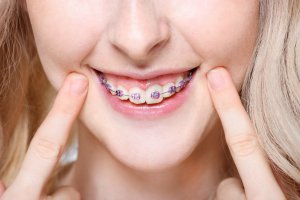
Metal braces are fixed braces that consist of metal brackets that attach to the front of your teeth and are connected with a metal wire. Fixed braces need to be put on and removed by a dentist or orthodontist, which is why they are ‘fixed’. Patients can wear them on both the top and bottom of their teeth or just on one arch.
There are a few different types of braces but traditional braces are the most well known. They are also the most affordable, which is part of the reason they are so commonly used. Traditional braces are available on the NHS if you meet their criteria.
How do metal brackets work?
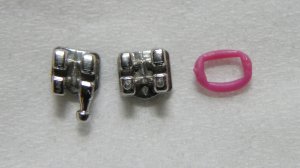
The metal brackets are connected by a wire that works to apply pressure to your teeth and guide them into the desired position over time. Rubber bands are used to secure the arch wire to the brackets, and apply extra pressure in certain areas to better align your teeth.
When you first go in to get your braces put on, the dentist will use dental cement to attach the small metal brackets to the front of your teeth. Then a wire will be secured with rubber bands to connect the brackets.
You will need to go for regular appointments with your dentist or orthodontist to have your braces adjusted. This is to check your teeth are moving in the right directions and readjust the wire so that it applies pressure correctly.
How long do braces take?
How severe your orthodontic case is will affect how long you will need to wear braces. If you have mild to moderate problems, you may only need to have them on for 6 months. However, if your case is moderate to severe you might have to wear your braces for 2 years or more.
In some cases, like severe malocclusion, you may need to wear an orthodontic appliance before starting your braces treatment. An orthodontic appliance, like twin block braces, can add another 12 months to your treatment if your case is quite severe.
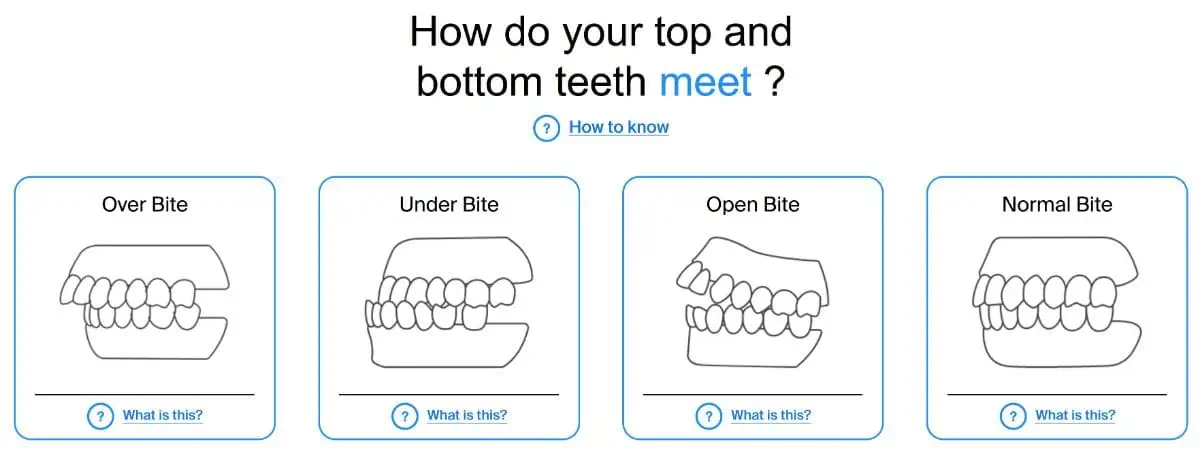
Do braces hurt?
Braces do cause discomfort and sometimes pain, but then again all orthodontic treatment does. That is because your teeth are moving and changing position which is going to hurt a little bit. There are a few different times during your braces treatment that teeth commonly hurt, including:
- When you first get your braces on
- After any adjustment appointments
- When you get your braces taken off
This is because your teeth and gums need time to adjust to any adjustments and additional pressure. Other times that you may experience pain is from cuts, ulcers or gum irritation from the metal brackets.
If you want to know how to deal with pain from braces, read our article here for tips.
Can you get orthodontic treatment on the NHS?
If you are eligible for braces the NHS will provide you with metal or sometimes ceramic braces. The criteria for getting braces with the NHS is quite stringent, so if you find you are not eligible you may have to opt for private care.
You are more likely to be eligible for NHS braces if your oral health is good, so make sure to take care of your teeth well if you are hoping to get braces. If you want to get braces on the NHS, watch the following video to learn more:
Who is eligible for traditional metal braces?
NHS dentists use The Index of Orthodontic Treatment Need (IOTN) to rate who is eligible for orthodontic care with the NHS. During your consultation, a dentist will use IOTN to categorise your teeth.
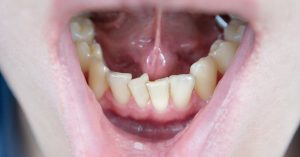
If you receive a grade 1 or 2 you will not be eligible and grade 3 means that your teeth are borderline and will be assessed for an aesthetic score as well. A Grade 4 and 5 means that you are most likely eligible for braces on the NHS.
However, even if you qualify for braces with the NHS you will still be placed on a waiting list. So, if you want braces sooner then you are better off getting private treatment if your budget allows it.
If you opt for private treatment then you are eligible for braces if you have the following issues:
- Crooked or misaligned teeth
- Gaps between teeth
- Protruding teeth
- Deep overbite
- Crowded teeth
If you only need mild orthodontic treatment, your dentist might suggest an alternative like clear aligners instead. But, they will take into account your lifestyle and budget when helping you come to a decision.
How much do braces cost?
If you are eligible for traditional braces with the NHS then the cost of braces is free for those under the age of 18, and £282.80 in England as a band 3 treatment.
If you get metal braces under private care, they will cost between £1,500 and £3,000 or more, depending on how severe your case is.
Alternatives to metal braces
Metal braces are not your only option when it comes to teeth straightening treatments. There are both fixed braces and removable braces to consider depending on your dental needs and budget.
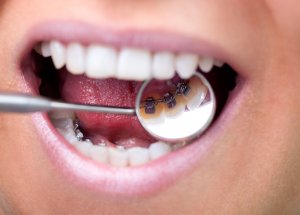
If you are considering fixed braces then you have the following alternatives to traditional braces:
- Ceramic braces – Clear, white or tooth-coloured brackets and metal or tooth-coloured wires
- Lingual braces – Brackets attach on the inside of your teeth so they are only visible when your mouth is open, also known as incognito braces.
- Self-ligating braces – Don’t need elastic bands to secure the wire, and are easier for your dentist to adjust. These braces generally have a shorter treatment length to conventional braces.
While braces can improve the look and function of your smile, they can also result in mouth ulcers.
In addition to being uncomfortable, these ulcers in your mouth can spread diseases since they are open
sores. Even though most infections are minor and resolve independently, they might develop into
significant issues if the situation worsens.
You can speak with a qualified orthodontist who can advise you on the best course of action to avoid
this problem.
Dr Azariy Yusupov, DDS, Amazing Smiles Orthodontics
Removable braces or clear aligners are a great way to get straight teeth without braces and they are the least visible when you are wearing them. They are removable clear plastic trays that are custom made for your teeth and bite. Your treatment is monitored by a dental professional and every couple of weeks you change to new aligners.
Clear aligners are suitable for mild to moderate cases but Invisalign can treat up to 90% of orthodontic cases.
Metal vs ceramic braces
Metal braces are the most affordable fixed braces, but if you are concerned about your appearance then ceramic braces are a great alternative.
Ceramic braces are very similar to metal braces, except the brackets are made from clear or tooth-coloured ceramic material. They also tend to be more modern in design, with the brackets being smaller and more rounder to avoid cutting or irritating the gums, cheeks or lips.
Metal braces vs Invisalign
As mentioned above, clear aligners like Invisalign are the least visible teeth straightening treatment out there. The only similarity they have with fixed braces is that they straighten and align teeth to improve your smile. The way they work to achieve those results is completely different.
While traditional braces are metal brackets, wires and elastic bands, Invisalign is clear plastic trays moulded to the shape of your teeth. This means that eating and drinking are much easier with clear aligners as well as whitening your teeth during treatment. Food can get stuck in fixed braces and they can be harder to clean, flossing is more complicated and teeth whitening with braces is just not possible.
Both treatments are monitored by dental professionals, but Invisalign tends to have a shorter treatment time scale. Generally, fixed braces are known to treat more complicated cases and clear aligners treat milder cases. However, Invisalign, the most popular aligner on the market can treat up to 90% of orthodontic cases.
Conclusion
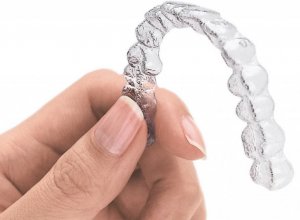
Metal braces can treat a range of orthodontic problems, but unfortunately, they will give you a mouth full of metal. Some might say that it is worth it for a beautiful smile at the end of the treatment, and others prefer to look at other treatment options.
Fixed braces are usually made from metal brackets and are connected by wires held in place by elastic bands giving them the nickname ‘train tracks‘. But, there are alternatives to the traditional fixed brace, including lingual, self-ligating and ceramic braces that are more modern in their technology.
Ceramic braces and lingual braces are much less visible than other fixed braces, but if how you look is a concern of yours then consider clear aligners. Clear aligners generally treat milder issues but if your case is more complicated you may still be eligible for Invisalign.
We recommend consulting your dentist or orthodontist before making a decision on your treatment.
NHS. Braces and orthodontics. Consulted 17th August 2021.
BOS. What Is The IOTN? Consulted 17th August 2021.




